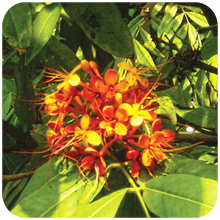
Saraca Asoca is an important tree in the cultural traditions of the Indian subcontinent and adjacent areas. Saraca asoca is an evergreen tree. The leaves are paripinnate with 6 to 12, oblong and rigid sub-coriaceus leaflets. The tree is known mainly for its beautiful foliage and fragrant flowers. The flowers are orange or orange-yellow in color, very fragrant and dense in axillary corymbs. The fruit is flat hard pod with 4-8 ellipsoids, elongated and compressed seeds.
Chemical composition – Contains tannins and catechol, epicatechin, procyanidins p2, 11′-deoxyprocyanidine B, catechins, catechol, phenolic and non phenolic glycosides, leucopelargonidin and leucocyanidin. It also contains saracacine, saracadine, waxy substances, fatty acids, flavonoids.
Properties – Astringent, anthelmintic, demulcent, emollient and stomachic, anti leucorrhoea, antibilious, uterine relaxant, anti-bacterial, uterine tonic, antidiabetic, antisyphilis, demulcent, antihemorrhagic, antioxitocic, anti-inflammatory etc..
Recommendation – Menorrhagia, metropathy, menstrual pain, excessive menstrual bleeding, irregular menstruation, uterine disorders, kidney stones, amenorrhea, calcium deficiency, colic, hemorrhoids, ulcers, fractures, dyspepsia, inflammation, dysentery, scabies, dyspepsia, indigestion, burning sensation, blood disorders, tumors, hemiplegia.
This plant is incorporated in natural remedies KAMAIANY, SHECURE Syrup.




